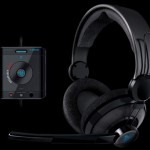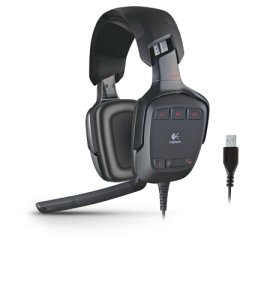 I had been saving up for months so that I could get this headset before going back on the road. Why, you ask? Well for one thing, my surround headset of choice, the Medusa, was a 5.1 surround headset with analog connections — meaning it plugs into the audio out ports of your sound card, or for that matter, any regular audio equipment that accepts stereo mini plugs. I liked this option at the time because it’s compatible with all audio equipment and allows your sound card to do the heavy lifting, which is what it’s there for, after all. The other option, which the Medusa also offers, is to get it with a USB connector, in which case your computer has to figure out how the surround sounds should be sent out to your hardware, creating extra processing work. And of course, you can’t plug a USB connector into your stereo or TV. At least you couldn’t back then, what do I know about these newfangled TVs and stereos?
I had been saving up for months so that I could get this headset before going back on the road. Why, you ask? Well for one thing, my surround headset of choice, the Medusa, was a 5.1 surround headset with analog connections — meaning it plugs into the audio out ports of your sound card, or for that matter, any regular audio equipment that accepts stereo mini plugs. I liked this option at the time because it’s compatible with all audio equipment and allows your sound card to do the heavy lifting, which is what it’s there for, after all. The other option, which the Medusa also offers, is to get it with a USB connector, in which case your computer has to figure out how the surround sounds should be sent out to your hardware, creating extra processing work. And of course, you can’t plug a USB connector into your stereo or TV. At least you couldn’t back then, what do I know about these newfangled TVs and stereos?
Then something happened that changed my mind: I started spending way more time away from home than at home, and suddenly my big fancy gaming PC was collecting dust, and I had to cobble together a way to make my laptop satisfying for gaming long-term.
My immediate solution was to connect the Medusa with its analog connections as a stereo headset to my Macbook Pro. First of all, you immediately lose the point of having such a nice headset, because the laptop (or most laptops for that matter) don’t support analog surround sound. So it’s just a really expensive stereo headset with a mic. Oh, and about the mic — the Macbook Pro’s audio-in jack is line-level, it doesn’t support unpowered mics, so you need Griffin’s iMic USB adapter or something similar. It’s a lot of crap to carry around, with no better performance than a cheap $15 USB headset from Radio Shack.
So this past summer, I bought a cheap $15 Radio Shack headset, just to carry to the theatre, and laughed when the guys I play online with said I sounded much better than on my old ($125) headset.
But the true problem I was having with life on the road was the lack of surround sound. The game I play, Battleground Europe, is very audio-dependent if you want to survive for long as infantry, and playing in stereo basically means spinning in circles to figure out where a sound is coming from based on where it sounds loudest. The way I was used to playing is that I could hear a single rifle shot and know if it was friendly or enemy, almost an exact direction, and an approximate distance. With one shot I would know exactly where the enemy was, and could turn right to him and shoot back, or move quickly to flank around him if he wasn’t visible. With stereo headphones that’s not possible at all. So I realized that the circumstances of my life required that I would need a USB headset if I ever hoped to play with surround.
It was around this time that Razer released the Megalodon — a 7.1 surround headset, powered by USB, and featuring a nice control box that allows you to adjust volume and a number of other features with just a few buttons.
I saved up all summer, and purchased it in the fall to prepare for going on the road. And now I’ve used it enough to answer all your burning questions.
Wait – first of all, what is a Megalodon?
Razer likes to name their products after fearsome animals. Sort of like how the Navy names different classes of ships after states, presidents, etc., Razer also has naming conventions. Mice are always snakes, for instance (see my review of the Mamba). Well headsets are… fish. Usually bad-ass fish. Cause nobody wants to brag about how they’re gonna frag your ass with their Goldfish.
The megalodon is a shark (thank you, Wikipedia). As you might have guessed from the name, which sounds kind of like it means “big-ass dinosaur,” it’s a prehistoric shark, a friggin’ huge prehistoric shark, which is estimated to have been up to 56ft in length.
Here’s a dude sitting in one’s mouth. RAAAAWWRR!!

Are you gonna review this thing or not?
Hold your horses, you’re gonna get some educatin’ with your gaming peripheral review. OK, now I’m ready.
Setup
The Megalodon connects to your computer with a simple USB plug. According to the specs it does not require USB 2.0, but a powered USB port is recommended. I tried it in my keyboard USB port (which is USB 1.1 and connected through a hub), and it was none too happy.
You don’t have to install any drivers, they are built into the control box and will automatically configure whatever computer you plug it into. Nice, huh?
Because the headphones are USB, they don’t require a sound card, which is good if you’ve got crappy sound in your rig or laptop, or bad if you’ve got a really expensive sound card waiting to be used.
The Control Box
About four feet down the braided-fiber-covered cable from the headset is the control box, which looks kind of like an iPod that’s been attacked by a gaming device. It has a scroll wheel (which actually turns like ye olde iPode, it’s not touch-sensitive). In the center is the Select button, with a nice light-up Razer logo on it.

On the left side is a volume meter which indicates different things depending on what mode it’s in, but usually it’s just your plain old volume.
At the top is a button that says Maelstrom. That’s Razer’s name for the technology that processes the 7.1 surround sound. You can push that button to toggle between 2.0 (stereo) and 7.1 mode, and the appropriate number will light up in blue on the left or right of the button. It will also cause the speaker icons around the box to light up, to show all seven speakers, or just the two at the top. Razer recommends listening to stereo sources in 2.0 mode, because the Maelstrom engine is apparently not helpful unless your source is 5.1 or 7.1 surround, and will just make it sound kind of funny.
There are three buttons on the bottom of the scroll wheel, all of which are mic-related:
- Mic mute — mutes the mic, of course, and also lights up red when activated, so hopefully you’ll notice that you’re muted and not talk to yourself for 10 minutes like one of my squad leaders is fond of doing
- Mic sens — while this button is pressed you can use the scroll wheel to adjust the mic’s sensitivity (shown on the volume meter)
- Mic level — adjusts the volume of your mic’s output
The nice thing about these features is that when they are activated you can hear yourself in the earphones, so you can check right away how it sounds (in the business this is called sidetone, which is one of those terms that makes me feel really smart when I use it to explain what’s wrong with my comm).
Other Features
If you press the center button it will highlight each set of speakers on the control box and let you adjust their relative levels. You can’t independently set levels for left and right, only for each type: center, front, middle, rear, and bass.
There’s also a hidden, undocumented setting where you hold something while pressing something else. I can’t remember what it does, though. But when I find it I’ll add it.
These are all you get — there is no software to install, which also means no control over the finer points of your audio experience. They plug in and they work. I find that really great for being on the road, but it’s a little unnerving as a PC gamer geek. However, I have never felt a strong desire to tinker with the settings, which is more than I can say for the Medusa, which was mostly a product of my sound card (SB Audigy 2ZS) flipping the hell out every time I changed video drivers.
The Hardware
The main difference between these headphones and the Medusa (well basically between the Medusa and any other gaming headphones I know of) is that the Medusa creates surround sound by actually having three separate speakers in each earpiece. Most other headsets use software to figure out how to balance each sound to trick your ear into perceiving its correct direction. I thought the Medusas were pretty amazing, but the Megalodon does a nice job of indicating direction, too.
The first thing I really like about these, especially for travel purposes, is that they’re very light. They look just as bulky, but the materials are very lightweight. If you have an unruly child, or perhaps just like slamming your headset on your desk when you get killed in particularly inglorious fashion, I’d wager they won’t hold up nearly as well. But if you can be a civilized gamer, the build quality seems good, if a little more delicate.
The mic is a single piece of plastic, it doesn’t bend into position. It has a little bit of flexibility in the middle, though I don’t think that allows you to keep the shape you want, it just bends enough so it doesn’t snap accidentally. My professional feeling on headset mic booms, if you really want to know, is that I prefer the ones you can bend into any shape… until they get worn out and won’t stay where you put them. The nice thing about the solid ones is that when you put them somewhere, you can trust that they’re still there the next time you have to call a cue. And I feel the same way about gaming headsets.
The headset seems to shrink down to a pretty small size for an adult head, and expands quite a bit. I don’t know how it would do with a little kid, as thankfully I don’t have any kids here to test with, so I think you’ll have to look elsewhere for opinions if you’re a really cool and/or crazy parent to buy your small child a $150 headset.
The velvet ear pads are very comfortable. The headphones don’t block out outside noise particularly well, but that’s not always a bad thing.
Accessories
One of the coolest things about this headset, that caught me completely by surprise when I opened it, is the carrying case it comes with. It has a semi-hard shell, molded to fit the headset and control box on the inside, which closes with a zipper, clam-shell style. If you stomped on it, bad things might happen, but it will definitely keep your headset safe in most travel situations, and like the headset itself, is surprisingly lightweight, so there’s no reason not to use it. I can’t wait to go on the road with this thing. I will feel better about traveling with my expensive headset, and will know that the cord won’t be getting all tangled up in my pajamas. Getting pajamas at gametime or headset at bedtime is not productive. It’s going to be a very clear distinction from now on.

My rough scientific analysis which consisted of me stepping on a scale both holding and not-holding the case with headset in it puts its total weight at 1.5lbs. I’ve probably told you I obsess over the weight of my suitcase, so this is very good news. Incidentally, the Medusa weighs 1lb, without a case or control box.
Does it work with Mac?
![]() Razer’s official answer on this is kind of, “um, maybe, we think, but we’re not sure.” What I can tell you is that you can definitely plug them in and listen to regular audio with them (you have to select them in your audio settings to make the headphones and mic the active input and output). I don’t have any surround games to play with on the Mac end right now, but on listening to a few minutes of a 5.1 DVD, it certainly sounded like it was working. Which pretty much convinced me that that’s the only way I can ever listen to a DVD on my Mac again.
Razer’s official answer on this is kind of, “um, maybe, we think, but we’re not sure.” What I can tell you is that you can definitely plug them in and listen to regular audio with them (you have to select them in your audio settings to make the headphones and mic the active input and output). I don’t have any surround games to play with on the Mac end right now, but on listening to a few minutes of a 5.1 DVD, it certainly sounded like it was working. Which pretty much convinced me that that’s the only way I can ever listen to a DVD on my Mac again.
Does it work with TrackIR’s TrackClip Pro?
Yes. The TrackClip Pro clips rather nicely to the headband, as shown here.

Summary
Pros
- light weight
- simple, literally plug-and-play setup
- awesome carrying case
- comfortable fit
- no soundcard required
- easy access to volume and mic settings
- shape is compatible with TrackIR TrackClip Pro
Cons
- no detailed software configuration possible
- control box adds bulk compared to simpler alternatives
- I wish there was a simple audio out jack on the control box so I could plug in external speakers or otherwise get sound out besides using the headphones.
- not compatible with standard audio equipment, or console gaming systems
Overall I’m very happy with it. There’s not much to play with, but I think especially on the road that will be very good. I don’t have a lot of time to play, and if I’m in a hotel at all it’s generally a new one every night. Being able to take the headset out of the bag and plug it in without worrying any more about it for the rest of the night is just what I need.
Alternatives
If the lack of software controls bothers you, there is also the Logitech G35 7.1 headset which has its own control panel and apparently some nice features. Before you get all excited, I will leave you with a picture of what it looks like:




About The Compatible With Razer Megalodon
[…] e Medusa and any other gaming headphones I know of) is that the Medusa creates s […]
Trackback by Attitude Blog — March 30, 2017 @ 4:32 pm